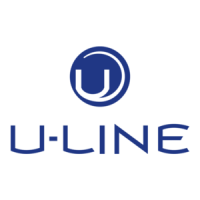Why are my U-Line Trucks leaking?
- Jjoseph44Aug 14, 2025
If your U-Line Trucks are leaking, it's likely due to worn or damaged seals. Replace the seals with new ones. Also, check for cracked or worn-out parts and replace them as needed.

Why are my U-Line Trucks leaking?
If your U-Line Trucks are leaking, it's likely due to worn or damaged seals. Replace the seals with new ones. Also, check for cracked or worn-out parts and replace them as needed.
Why do the forks descend without being lowered on my U-Line Lifting Systems?
If the forks on your U-Line Lifting Systems descend without being lowered, it could be due to impurities in the oil preventing the discharge valve from closing properly. Try changing the oil. Another possible cause is air in the hydraulic oil; in this case, you should expel the air.
What to do if my U-Line Lifting Systems has leaks?
Leaks in your U-Line Lifting Systems can be caused by worn out or damaged seals. Replace the seals with new ones. Also, check for cracked or worn out parts and replace them as needed.
Why do the forks on my U-Line H-5387 not raise?
If the forks on your U-Line Lifting Systems do not raise, it could be due to several reasons. First, check if there is enough hydraulic oil and add more if needed. The oil might have impurities, requiring an oil change. The discharge valve may be out of adjustment, so adjust the setting screw. Additionally, air in the hydraulic oil can cause this issue; expel the air.
What to do if the forks do not descend on my U-Line H-5387 Lifting Systems?
If the forks on your U-Line Lifting Systems do not descend, it could be because the rod and/or the cylinder are deformed due to a seriously unbalanced load. Replace the rod or cylinder. Another possibility is that a part has been broken or deformed from an unbalanced load; repair or replace the component. Also, the setting screw may not be in the correct position, so adjust it.
What to do if the forks on my U-Line Trucks do not raise?
If the forks on your U-Line Trucks aren't raising, several issues could be the cause. First, check if there is enough hydraulic oil and add more if needed. Secondly, the oil may have impurities, in which case you should change the oil. Other potential causes include a discharge valve that is out of adjustment, which requires adjusting the setting screw, or air in the hydraulic oil, which needs to be expelled.
Why do the forks on my U-Line Trucks descend without being lowered?
If the forks on your U-Line Trucks descend without being lowered, it could be due to several reasons: impurities in the oil may be preventing the discharge valve from closing properly, so try changing the oil. Another possibility is air in the hydraulic oil, which needs to be expelled. Worn or damaged seals can also cause this issue, so replace them. Finally, check if the setting screw is in the correct position and adjust it if necessary.
What to do if the forks on my U-Line Trucks do not descend?
If the forks on your U-Line Trucks aren't descending, this may be because the rod and/or the cylinder are deformed due to a seriously unbalanced load, in which case you should replace the rod or cylinder. Another cause may be that a part has been broken or deformed resulting from an unbalanced load, so you should repair or replace the component. Also, ensure that the setting screw is in the correct position and adjust it if necessary.
How to fix forks on U-Line Trucks not lifting to maximum height?
If the forks on your U-Line Trucks aren't lifting to their maximum height, it's likely that there isn't enough hydraulic oil. Add more oil to resolve this issue.
| Brand | U-Line |
|---|---|
| Model | H-5387 |
| Category | Lifting Systems |
| Language | English |
Essential safety and operational instructions must be read and understood before using the pallet truck.
Explanation of the control lever positions: LOWER, NEUTRAL, and RAISE for operating the pallet truck.
Guidance on adjusting the setting screw to correct fork operation issues in NEUTRAL and LOWER positions.
Instructions for checking oil level, capacity, type, and viscosity for proper hydraulic system function.
Procedure to remove air from the hydraulic pump unit to ensure correct operation.
Daily inspection recommendations and lubrication guidance for movable parts.
Key safety rules including training, avoiding slopes, keeping body parts clear, and proper load handling.
Guidelines on load capacity, centering, fork length matching, and lowering forks when not in use.
Troubleshooting steps for when the forks fail to reach their maximum lifting height.
Solutions for when the pallet truck forks do not lift when the handle is pumped.
Recommendations for addressing issues where the forks do not lower when the control lever is in the LOWER position.
Identifying and resolving leaks in the hydraulic system due to worn seals or other component issues.
Steps to fix the problem of forks lowering on their own, often related to oil impurities or setting screws.
